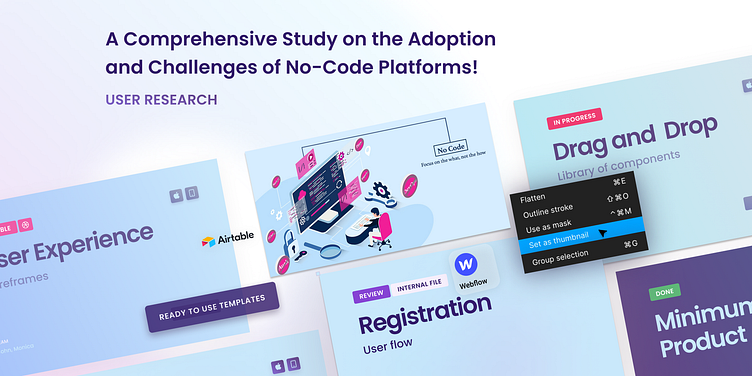A Comprehensive Study on the Adoption and Challenges of No-Code
Objective
The main goal of this study is to gain deep insight into the problems faced by three different groups: those who are already using No-Code platforms, those who know of the existence of and may consider using such tools in the future, and those with no knowledge of the No-Code development industry. This effort will seek to uncover key insights by pinpointing challenges, frustrations, and unmet needs across the groups to understand how to enhance No-Code platforms, increase user adoption, and make better strategic decisions for stakeholders in the technology sector.
The No-Code Development Market Landscape
No-code development platforms have gained significant traction in recent years, transforming the landscape of application development by enabling users to create software solutions without extensive coding knowledge. These platforms cater to a diverse audience, including business professionals, entrepreneurs, and small business owners, allowing them to build applications quickly and efficiently using intuitive drag-and-drop interfaces. The market for no- code platforms is rapidly expanding, driven by the increasing demand for digital solutions and the ongoing shortage of skilled software developers. According to industry reports, the global no-code development platform market is projected to reach approximately $21 billion by 2025, growing at a compound annual growth rate (CAGR) of 28% from 2020. This growth is fueled by organizations' need to accelerate their digital transformation efforts and improve operational efficiencies
About the No-Code User Research
The main goal of this study is to gain deep insight into the problems faced by three different groups: those who are already using No-Code platforms, those who know of the existence of and may consider using such tools in the future, and those with no knowledge of the No-Code development industry. This effort will seek to uncover key insights by pinpointing challenges, frustrations, and unmet needs across the groups to understand how to enhance No-Code platforms, increase user adoption, and make better strategic decisions for stakeholders in the technology sector.
Current Users of No-Code Platforms:
Identify recurring difficulties users face, such as limitations in platform capabilities, usability issues, or the learning curve associated with using No-Code tools.
It is important to identify the areas in which current platforms do not fulfill user expectations, particularly regarding functionality, flexibility, or support.
Document any workarounds or alternative toolsusers employ to overcome these challenges, providing insight into potential areas for platform improvement.
Potential future no-code platform users:
Concerns and hesitations — Understand the barriers preventing these users from adopting No-Code solutions, such as perceived complexity, doubts about effectiveness, or lack of awareness about available platforms.
Needs and Expectations- Explore the functionalities or capabilities which, if added, would eventually make these users try a No- Code platform and what results they want to achieve.
Individuals Unaware of No-Code Platforms
Awareness and Knowledge Gaps- Assess thelevel of awareness and understanding of No- Code platforms in this group, listing any misconceptions or knowledge gaps.
Interest and Potential- Understand the interest in No-Code solutions if introduced and what level of information or education would be required to onboard such users.
Setting the priority for no-code platforms — Key Insights
Why do they use no-code platforms?
To Create MVPs Quickly Startups and businesses use no-code platforms to rapidly develop MVPs (Minimum Viable Products) and full application prototypes without the need for a full development team.
Why do they dislike no-code platforms?
#1 Expensive: Subscription costs for no-code platforms, especially with advanced features, can quickly add up and
become expensive in the long run.
#2 Restrictions & Template-Based Limitations: Many no-code platforms are heavily reliant on templates, which users
feel restrictive and may not provide the flexibility needed for fully customized solutions.
#3 Inability to Scale: Users struggle to scale as projects grow, especially with more complex requirements, resulting in performance issues or limitations.
#4 Lack of Community Support: Finding help can be challenging, as there is limited community support or fewer experienced developers familiar with the platform
.
Why do love using no-code platforms?
Drag-and-Drop Simplicity The intuitive drag-and-drop interface makes designing websites and apps easy for anyone, speeding up development without the need for coding
Flexibility to Iterate Users can quickly make changes to their product, enabling them to iterate on ideas, test new features, and make refinements in real-time.
PLEASE CHECK THE FOLLOWING LINK FOR DETAILED USER RESEARCH
